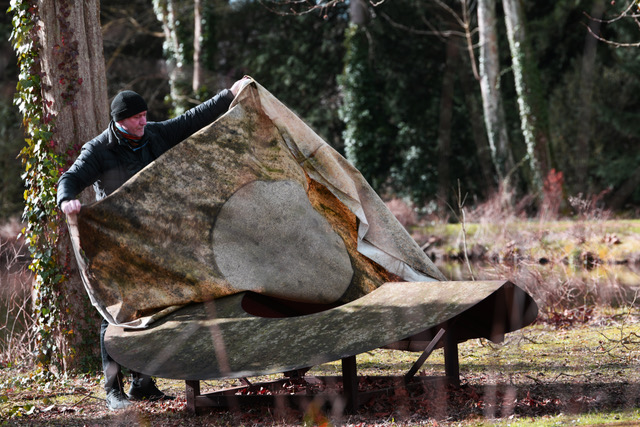BORDERIE – JOUSSE
Le laisser faire – Clément Borderie
“Just when technological innovations are invading the art world, I think that the Living World is sending us a crucial message, in its own language… For my part, I am incorporating it as a creative process within my research”. Clément Borderie’s declaration, with its very speci c echoes in this moment of health crisis, reminds us that his environmental concerns have been at the heart of his work for well-nigh thirty years. The artist has in e ect asserted his own identity by drawing the main themes of his work from nature, as illustrated by the “matrices”, which are especially emblematic of his approach based on the principle of process or “permanent change” (Clément Borderie). With their thoroughly minimalist sobriety, the canvases produced through the matrices are worked on over a very extended time-frame, which includes notions of evolution and organic decomposition. Exposed outdoors for a period varying from six to twelve months, these raw cotton canvases, stretched on steel structures of di ering shapes (torus, sine curve, circles), accommodate natural elements present in the atmosphere, such as water, air, dust, dead leaves, pollen, and other organic residue.
Over and above a certain interest in the in situ experiment, these works materially incarnate the irreversible character of time’s passage. As Clément Borderie explains, the brief of the matrices “is to trap space-time reality; the idea being to make time visible, crystallize it in an image, and trap its depth”. The canvases produced by the matrices, whose time layers he likes to compare with
a millefeuille, plunge us into a disturbing time-frame somewhere between past and present, between traces and erasure. They go hand-in-hand with the artist himself stepping back, which limits his intervention to the choice of the place to be used and the no less decisive choice of putting an end to this work in progress: “the work – Clément Borderie explains – is the whole process. The nal canvas is the time T of all that. The cessation of the process is a magic moment which belongs to me”. This precise moment is when the forces in action during the autonomous genesis of the work, which the artist calls “art bosons”, achieve a balance which is akin to the sublime.
For Clément Borderie, the creative person is not so much a direct producer of forms or style, but a kind of go-between whose aims to make the imperceptible visible and the ephemeral material. This distancing, which permanently accompanies the artist’s keen and demanding gaze, is also evident in the Pierre de sel (or licking stone) series, which are originally a mineral salt food complement for animals. These spotlessly white blocks, whose surfaces sculpted by animals’ tongues are informed by a delicate alternation of solids and voids, have acquired artwork status by the mere fact of having been located in the countryside by the artist and diverted from their primary function. If such an approach echoes Marcel Duchamp’s readymade, Clément Borderie di ers because the selection criterion is not based on indi erence but on “aesthetic delight” (to use the words of Ghislaine Rios, author of the book Les Bosons de l’art, written on the work of Clément Borderie based on conversation with the artist).
In his vast and surprising grasp of the Living World, Clément Borderie has produced a video titled Sarabande, which shows cows
in their barn at milking time. The artist does not focus only on the to-and-fro of their legs ling past and crossing paths with unsuspected elegance. This very tight framing, heightened by the use of a pronounced chiaroscuro, isolates the scene from its context and gradually transposes it into another reality. From this there comes an impression of calm, serenity and suspended time. As the fruit of a humble and sensitive approach, Clément Borderie’s work emphasizes the creative process as much as the work itself. The subtle dialogue he ushers in between art and the Living World, recreating the experience of the world’s complexity, invites us to re ect and contemplate.
- Domitille d’Orgeval, 2020
* quote of Bernard Lamarche-Vadel in a text about the artist (see below)
The Borderie Process
Where are the works?
Does Borderie devise works?
One of the features of the modern tradition is that it in nitely questions its own genesis, as well as the presentation of a genetic memory which lends each work that fate of being the mirror-like conclusion of the reconciled origin and end. In this sense, Clément Borderie’s oeuvre is essentially modern. Rather than favouring the excellence of a closed viewpoint on the excellence of the application of a talent, his oeuvre extends to the very process it presents. So there are no good or bad works, but rather a system of conception, and to judge it is to judge its e ectiveness in being art, over and above all the introduced categories of its appropriation. The idea of designing an art-producing machine, from Duchamp by way of Tinguely, is here re-introduced in a very di erent way.
It is no longer Borderie’s machine which, per se, is capable of creating, but our environment in contact with this machinery that functions in the manner of a photographic development; whether some prefer the prints — meaning the plates, i.e. the paintings — and others the arrangement which permits their appearance, there is still the mystery of an experience in which the time factor of the work has become a ceaseless migration of its properties.
Bernard Lamarche-Vadel, 1989
Photo : Jacques-Yves Gucia
